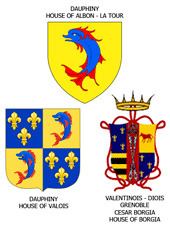 | ||
Creation date First: 1350 - Cedes to House of Borgia: 1498 Peerage French nobility - Vatican | ||
Count of Diois / Dyois is a title of nobility, originally in French peerage. It was created on 1350 inside Dauphine of Viennois Patrimony by Philip VI of France when Humbert II of Viennois sold his lands and titles to King Philip VI of France. All patrimony of Dauphine consisted in: Count of Albon, Grésivaudan, Briançonnais, Grenoble, Oisans, Briançon, Embrun and Gaph, Baron de La Tour du Pin, Dauphin of Viennois, count of Valentinois, and given to Cesar Borgia join to Duke of Valentinois by Louis XII of France.
Contents
Background
The county of Dyois born inside a Patrimony of Dauphiny of Viennois, an ancient group od lands and titles part of Holy Roman Empire since 1032. All titles were under Dauphin of Viennois denomination and Houses which were its owner, were powerful in low-middle age and renascence. On the XV century, Dauphiny of Viennois in head of House de La Tour du Pin, presented several conflicts in pursuit of absolutism Capet-Valois policy. It was a fortune for France that Humbert II de la Tour-du-Pin, last Duaphine of Viennois had been incompetent and extravagant, lacking the warlike ardour of his brother Guigues VIII. How Dauphine he depleted his treasury funding a vain Crusade to rescue the Holy Land, failuring at all in his propose and after the death of his only son André and without issue and being an incompetent and luxurious man, he decides sale his patrimony to the best offer.
With financial difficulties building up, he made an inventory of his possessions, with the hope of selling them to Pope Benedict XII in 1339, but when Pope Clement VI brought the two sides to negotiations, the terms included the possibility of Humbert marrying Bianca of Savoy, though this did not reach agreement. The planned sale to the pope falling through, Humbert finally succeeded in completing a sale to Philip VI of France in 1349 for 400,000 écus and an annual pension. To save appearances, however, the sale was referred to as a "transfer". In order to prevent the title from going into abeyance or being swallowed up in another sovereign title, Humbert instituted the "Delphinal Statute" whereby the Dauphiné was exempted from many taxes and imposts. This statute was subject to much parliamentary debate at regional level, as local leaders sought to defend their autonomy and privilege against the state.
Instituted from 1349 as Royal patrimony, Dauphiny of Viennois was transformed in Dauphiny of France, title was carried by all heirs of France. On 1498 and more that a century after, Louis XII of France divided Dauphiny lands and delivered Valence, Diois, Grenoble in quality of Dukedom and Counties at Cesar Borgia when Pope Alexander VI gave his support in pursuit of defense of great feudal lords and because annulled his marriage with Joan and instead married Anne of Brittany, the widow of his cousin Charles VIII. This marriage allowed Louis to reinforce the personal Union of Brittany and France.
Counts of Diois / Dyois
House of Valois
House of Borgia
Diois lands remained after dead of Cesar Borgia under Kingdom of France domine as part of dauphinate, with French revolution passed to Republic of France and Napoleonic empire until it was instaurated the third Republic of France when Diois remained joined to French Republic as region denominated Diois inside French Drôme department in southeastern France and the commune of Die.
According to actual laws in Republic of France, title Count of Diois doesn´t exist just like all of ancient noble titles of Kingdom of France and Nopoleonic empire; nevertheless, same laws permit its use like part of name as particle of dignity.
